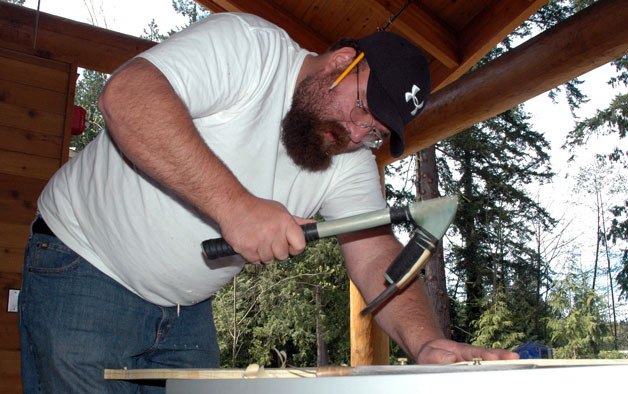TULALIP — Jason Gobin has been carving canoe paddles since the age of 6, when he started learning from his grandfather, and on Saturday, April 21, the Tulalip Tribal member gave visitors to the Hibulb Cultural Center a few of the insights he’s gleaned from his nearly three decades of experience.
As part of the Hibulb Cultural Center’s lecture and film series, Gobin treated spectators to a show, with the wood and carving tools that he’d brought along, and answered their questions about his practice as he worked.
“You have to watch your center line and side lines,” Gobin said as he hacked away at the pre-marked and partially pre-carved length of yellow cedar with an adz that he’d built himself. “If those are wavy, everything will come out crooked.”
Gobin dispelled the notion that a paddle needs to be thick to be strong, holding up a thin paddle that his grandfather had carved during the 1940s which is still usable today.
“It doesn’t need to be a club if it’s tapered right,” said Gobin, who nonetheless noted that some war paddles include sharp tips. “A lot of it is just feeling the high spots where the wood needs to come off. I’ve done hundreds of paddles myself, and I just go into automatic mode after a while.”
As with his grandfather’s paddle, Gobin emphasized that his own paddles are meant to be used rather than admired.
“They’re not meant to be hung on walls,” Gobin said. “They should go in the water. If the paint chips, just sand it down, and if it breaks, then I can build another one. I like that they’re utilitarian.”
Gobin explained that Tulalip Tribal paddle carvers strive to remain consistent to historic paddle designs, and touted the form of each design as following its function.
“You can see these same styles of paddles in our exhibits here,” Gobin said at the Hibulb Cultural Center. “We use them as our templates. The ones with pointed tips are for seal hunting, and they’re more stealthy because they make less noise. The longer ones offer more stability, the shorter ones are for sprinting and the bigger ones serve as rudders.”
With minor variations for style, Gobin sees most Puget Sound tribal canoe paddles as following similar patterns, although some of the river paddles are more properly described as 20-foot-long fir poles. He prefers yellow cedar because it’s easy to carve yet still durable, and noted that red cedar is prone to fatigue, while the strength of spruce paddles is offset by their tendency to sliver.
“It’s light like yellow cedar, though,” Gobin said. “Just a little bit of weight can make all the difference when you’re swinging the same heavy paddle for 10,000 strokes.”
Although Gobin uses a saw to cut the pattern for his paddles, he still relies on handmade tools such as his adz to do much of the tapering and shaving down. Swap meets have proven to be a fruitful resource for his tool parts, as he uses a plasma cutter to carve off pieces of blades from sawmills and snowmobiles.
“The older the steel, the better,” Gobin said. “When you build the tools that help you build the tools to create what you want, it makes you appreciate it all the more.”
While canoe paddle carving might seem like an antiquated hobby, Gobin sees it as a practice that’s retained its significance into the modern era.
“It’s never gone away, but now with the canoe journeys, it’s making a comeback,” Gobin said. “Our young tribal members are being taught how to build these paddles, to carry on this tradition. This is a living thing. I’ve always seen it as my job to train my replacements.”
The Hibulb Cultural Center’s lecture and film series will continue on Thursday, April 26, at 5 p.m. with Deborah Parker — a Tulalip Tribal Board member, policy analyst, actress and traditionalist — screening “The Shadow of the Salmon” in the Hibulb Longhouse Room. For more information, log onto www.hibulbculturalcenter.org.



